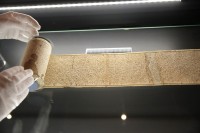 The original manuscript of the Marquis de Sade’s The 120 Days of Sodom has been declared national treasure by the French government. You might recall that over two years ago I wrote about how the thin (5 inches), very long (39 feet) parchment scroll on which the Marquis de Sade wrote what he considered his masterpiece was going up for auction. The circumstances were shady, to put it mildly. Quick summary: the scroll had been stolen in the early 1980s from the legitimate owner, Natalie de Noailles, daughter of a viscount and descendant of de Sade’s on her mother’s side and was sold in Switzerland (surprising no one) to an erotica collector. Noailles sued in French court, won, and the judgment was simply ignored by the Swiss collector.
The original manuscript of the Marquis de Sade’s The 120 Days of Sodom has been declared national treasure by the French government. You might recall that over two years ago I wrote about how the thin (5 inches), very long (39 feet) parchment scroll on which the Marquis de Sade wrote what he considered his masterpiece was going up for auction. The circumstances were shady, to put it mildly. Quick summary: the scroll had been stolen in the early 1980s from the legitimate owner, Natalie de Noailles, daughter of a viscount and descendant of de Sade’s on her mother’s side and was sold in Switzerland (surprising no one) to an erotica collector. Noailles sued in French court, won, and the judgment was simply ignored by the Swiss collector.
 After his death, his heirs sold the parchment with the blessing of a ridiculous and offensive Swiss federal court judgment contradicting the French one. In 2014, the manuscript was sold to avid collector Gérard Lhéritier, founder of Aristophil which turned out to be not so much as a company as a Ponzi scheme that used the collection of important manuscripts and autographs to defraud people of their money. When Lhéritier and his operators were arrested in March of 2015, the collection was confiscated. Now there would be a new court ruling, and this one wasn’t so easy to ignore. The entire collection of hundreds of thousands of historic manuscripts was to be sold at auction with the profits split among creditors.
After his death, his heirs sold the parchment with the blessing of a ridiculous and offensive Swiss federal court judgment contradicting the French one. In 2014, the manuscript was sold to avid collector Gérard Lhéritier, founder of Aristophil which turned out to be not so much as a company as a Ponzi scheme that used the collection of important manuscripts and autographs to defraud people of their money. When Lhéritier and his operators were arrested in March of 2015, the collection was confiscated. Now there would be a new court ruling, and this one wasn’t so easy to ignore. The entire collection of hundreds of thousands of historic manuscripts was to be sold at auction with the profits split among creditors.
With Lhéritier vociferously claiming his innocence, the slow wheels of French justice kept on a’grindin’. In October 2016, a court appointed the auction house Aguttes to sell off the collection. In November 2017, the auction house Drouet announced it would hold the first of more than 300 auctions over six years so the market wouldn’t be flooded with important manuscripts and prices driven down.
 Meanwhile, the Bibliothèque Nationale de France, which before the sale to Lhéritier had negotiated a complicated deal to acquire the manuscript on terms the sellers, the Noailles family and the French legal system could live with only to have it fall through at the last minute, was working another angle. If they could get the scroll declared national treasure, then its sale would be impeded.
Meanwhile, the Bibliothèque Nationale de France, which before the sale to Lhéritier had negotiated a complicated deal to acquire the manuscript on terms the sellers, the Noailles family and the French legal system could live with only to have it fall through at the last minute, was working another angle. If they could get the scroll declared national treasure, then its sale would be impeded.
It took a long time, but France has indeed classified the de Sade manuscript as a trésor national. That means its export is barred and thus it cannot be sold internationally. The government will have 30 months to make a purchase offer of a sum equivalent to the “international market value” which is certainly many millions of euros. The Bibliothèque Nationale de France raised five million to buy the scroll in the deal that fell through and that was years ago.
 The scroll is undeniable an icon of French literature and a microcosm of political and moral controversies of the ancien regime, French Revolution and early Napoleonic era. The Marquis de Sade wrote it from scraps of parchment attached together to form a long, skinny scroll that looks more than a little toilet papery (very thematically appropriate considering the subjects he explores in the tome) while he was imprisoned in the Bastille. He didn’t quite make it to liberation on July 14th, 1789. Ten days before it was stormed, he was transferred from his rather nicely appointed prison cell to the Charenton insane asylum without warning or opportunity to collect his stuff in punishment for riling up the Revolutionary mob milling around outside by hollering “They’re killing prisoners in here!”
The scroll is undeniable an icon of French literature and a microcosm of political and moral controversies of the ancien regime, French Revolution and early Napoleonic era. The Marquis de Sade wrote it from scraps of parchment attached together to form a long, skinny scroll that looks more than a little toilet papery (very thematically appropriate considering the subjects he explores in the tome) while he was imprisoned in the Bastille. He didn’t quite make it to liberation on July 14th, 1789. Ten days before it was stormed, he was transferred from his rather nicely appointed prison cell to the Charenton insane asylum without warning or opportunity to collect his stuff in punishment for riling up the Revolutionary mob milling around outside by hollering “They’re killing prisoners in here!”
A few days later, the tightly rolled scrolled was discovered in the crack of a wall in de Sade’s prison cell. The finder brought it home before eventually selling it and thus the long, strange journey of The 120 Days of Sodom got longer and stranger. So it survived the Bastille, it survived the sudden removal of its author, it got out of Dodge City before high noon and passed through multiple hands in three countries. It even found the time to get published in between all that, in two different editions, no less. Not bad for a janky roll of parchment scraps covered in spidery handwriting.
Now the question is, can a French institution actually afford this object? Stay tuned for the next exciting episode in the saga of The 120 Days of Sodom.
“Toilet paper very thematically appropriate” 😆 – Vive Lave Rance !
Sodom all
Sodom all
The long, the short and the tall…
:boogie: awesome ..you blog some of the most interesting and incredible stuff. .Write On :giggle:
Very interesting. I wonder why the Swiss court refused to accept the French courts decision. Hope the French Biblioteque receives it in the end.
Just as an aside, my great great grandfather’s writings and papers were donated to the University of Calif in Berkeley (he died in US) and his brothers papers went to the French Biblioteque. They ere the Leroux brothers who were French Deputies in 1848 and then exiled to the Isle of Jersey with Victor Hugo.
( And for those on their toes, I do have some varied and culturally mixed ancestors.)
I had an Intro to Eur. Hist. prof eons ago who had a penchant for telling vivid tales out history, true or not. He told one about Sade hanging out the windows riling up the crowds leading up to the Revolution. Nice to know he wasn’t totally full of it.
Appears to be good quality paper, not parchment – which would have been uncommon by this date. Distinctive and pleasant handwriting.